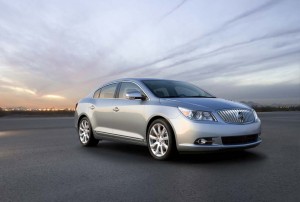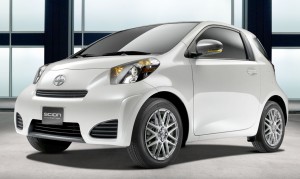The numbers at the pump down at Sunny’s Sunoco are spinning fast, these days. And getting faster all the time. He’s pumping regular at $3.19 a gallon, this morning, a big jump from just two weeks ago, but likely nothing compared to what we’ll see in the months to come.
Curiously, I hear a lot less complaining about fuel prices than I did in 2008, the last time we saw that rapid upward spiral. Perhaps panic will set in again if we start nudging $4 a gallon, but it just seems like most Americans have come to expect that number as an eventual reality. But it’s more than a matter of grin-and-bear-it.
Buyers are fighting back in their own ways. By driving fewer miles, according to government data, and by switching to more fuel efficient vehicles. Some are even considering vehicles that don’t few fuel at all, at least not in the liquid sense. And if fuel prices really do soar to new records in 2011, the pace of change could outstrip even the most optimistic forecasts –though don’t expect American roadways to start looking like those in Europe and Japan.

With the addition of the eAssist system, Buick's midsize LaCrosse will close in on the challening 40 mpg target.
The signs of change are obvious and unmistakable. Since 2008, there’s been a steady growth in small car sales. The compact C-segment now accounts for 25% of the market and, says Ford’s President of the Americas Mark Fields, “is expected to grow to 28% by 2014.” And that’s without a significant disruption in the price or supply of petroleum.
Ford hopes to take advantage of that trend by developing as many as 10 different offerings based on its own Global C-Car platform. The new Focus will be followed, in the U.S. by the C-Max microvan, for example. And, of course, Ford is pressing further down-market with the new Fiesta. A few years ago, subcompacts were a rare breed in the American market.
These days, virtually every maker offers one – or something even smaller. The upcoming Scion iQ will be barely a foot longer than the current Smart fortwo – but will have room for four.
Everywhere you look, folks are downsizing in one form or another, whether they’re trading a full-size SUV for a more compact offering, or shifting from a big V8 to a more economical six. In fact, some of the most dramatic changes are occurring almost out of sight.
“The real winner will be the company that can deliver a 40 mpg, non-hybrid midsize sedan,” contends Jim Hall, of 2953 Analytics. Americans, he contends, simply won’t switch to the mini and microcars popular abroad unless they have no alternative.
But that may not be necessary, at least not in the near to mid-term future. By switching to a crossover-based platform, rather than the traditional body-on-frame design of past models, and by downsizing its engine options, Ford is able to deliver a new 2011 Explorer that will average about 25% better fuel economy than before.
Hyundai, meanwhile, has entirely abandoned the V6 with its latest-generation Sonata – one of the three vehicles, incidentally, up for North American Car of the Year. And Buick claims its midsize 2012 LaCrosse will come darned close to Hall’s critical 40 mpg mark with its new microhybrid eAssist system.
We’re about to enter what some have dubbed “the year of electrification.” The Chevrolet Volt plug-in hybrid and Nissan Leaf battery-electric vehicles are just the first entries into a brave new world of electric propulsion. Significantly, both makers report that demand is far outstripping initial capacity, GM struggling to find ways to boost production of the Volt, and Nissan putting in place capacity for 250,000 battery cars annually by mid-decade.
Skeptics question whether the early interest will be maintained once the demand from enviro-buyers and early adopters is satisfied. But a new study by Pike Research suggests that “range anxiety will prove to be more fiction than fact,” which could bode well for the dozens of other battery-based vehicles scheduled to come to market by mid-decade.
Significantly, many will be offered by new entrants in what had long been a largely closed auto industry, Davids like Tesla, Fisker, Amp and others hoping to take down Goliaths like GM, Ford and Toyota – or at least capture a wee bit of territory.
But even if BEVs and plug-ins don’t turn on buyers – and the DriveGreen study from J.D. Power and Associates contends they’ll collectively account for just 7.3% of the market by 2020 – less complex technologies, like Buick’s eAssist, will become steadily more common. Ford will launch Stop/Start on its new Focus, and various analysts contend that feature – which briefly shuts down an idling engine – could be offered on more than half of all new models by mid-decade.
Such systems, along with advanced direct injection, turbocharging and other sophisticated enhancements to the internal combustion engine, should permit buyers to continue to get access to the full-size pickups and classic SUVs they have long bought by the millions.
It’s significant to note that sales of pickups like the Chevy Silverado actually began rebounding before gas prices fell back in mid-2008. But in the wake of the economic meltdown, demand has continued slipping and makers are clearly worried that another fuel price run-up might truly cripple the market for large trucks.
The coming year will almost certainly see a continuing trend away from big trucks for the personal use market, though commercial demand will depend on the state of the economy, more than anything.
Longer-term, what could be a death blow could be delivered by the EPA, which has briefly postponed a decision on the next round of Corporate Average Fuel Economy standards. But barring a serious pushback by the new GOP majority in the House, the federal agency likely will lock in a 62 mpg CAFE standard for 2025.
Such a number seems impossible to meet under any condition, right now – though that was the position the industry long took about the 2016 target of 35.5 mpg. And makers will get there even with their full-size trucks. But 62? Well, that would likely require major breakthroughs.
One way or the other, the trend towards smaller, more fuel-efficient products – whether conventionally-powered of battery-based – will only gain momentum in 2011. And another fuel price scare would simply accelerate the pace.
It would also impact another significant trend. As TheDetroitBureau.com recently reported, U.S. gasoline consumption has fallen a sizable 8% since demand peaked in 2006. And it’s expected to dip by a third by 2030. That trend seems inevitable, no matter what the economy and despite the upcoming boomlet as more Millennials get their driver’s licenses. (For the full story, Click Here.)
So, 2011 is certain to be a year of big change for automakers and auto buyers alike.

